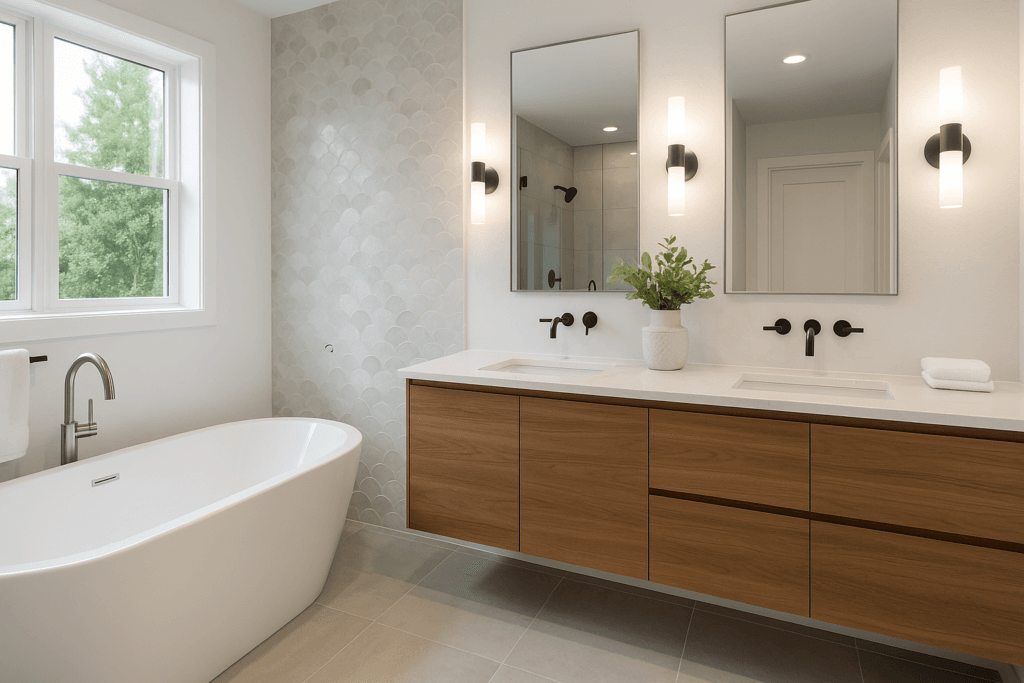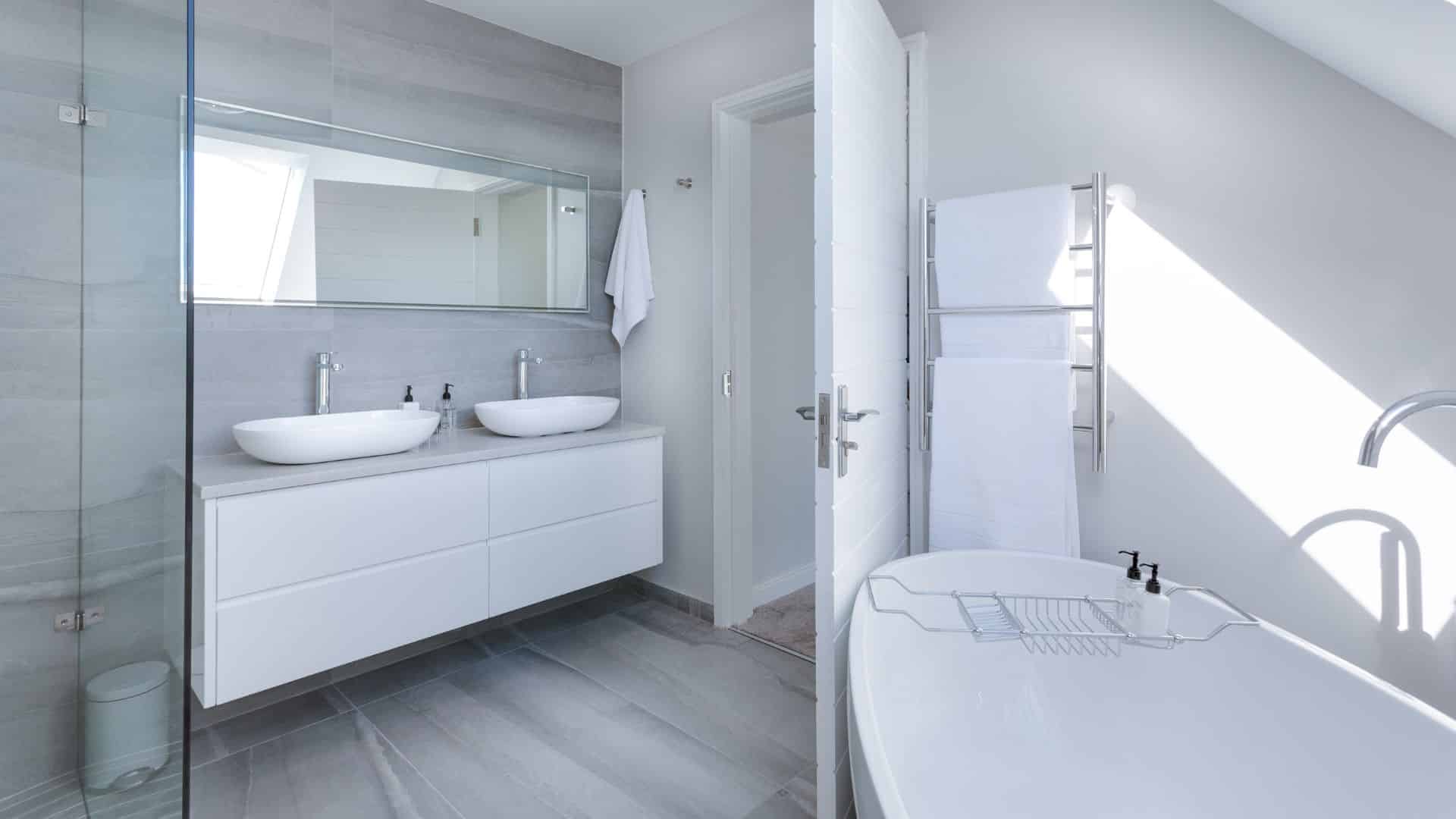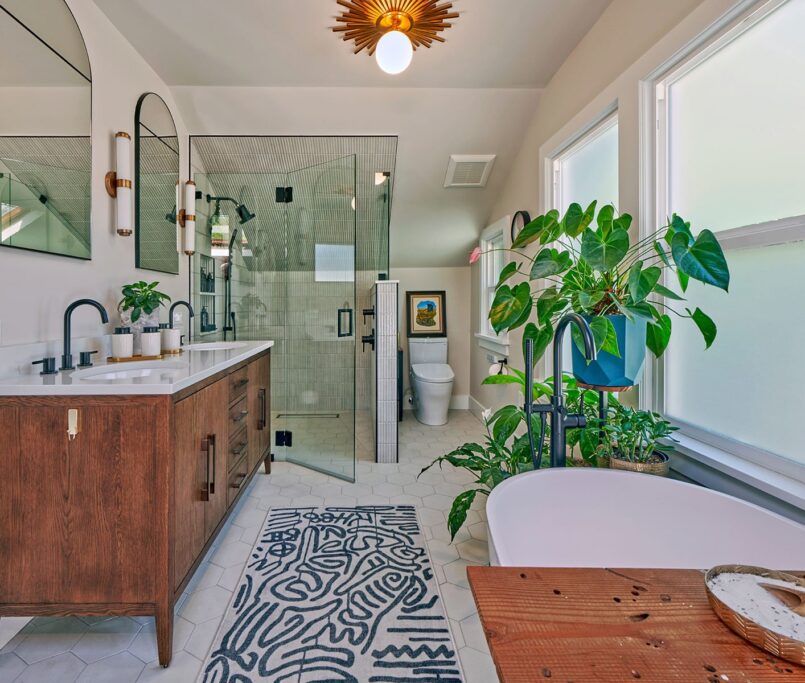Walk-In Shower vs. Tub: Which Is Best for Your Bathroom?
When remodeling your bathroom, one of the most important decisions you’ll make is whether to install a walk-in shower or a bathtub. This choice not only impacts the aesthetics of your space but also its functionality, comfort, and even resale value. Whether you’re aiming for a modern, sleek design or a more traditional, luxurious feel, both walk-in showers and tubs offer unique advantages.
However, there’s no one-size-fits-all answer. The right choice depends on your specific needs, bathroom size, and long-term goals. In this article, we’ll break down the pros and cons of each option to help you make an informed decision about which is best for your bathroom remodel.
Walk-In Shower: The Modern Choice
Walk-in showers have surged in popularity in recent years, and for good reason. Known for their clean, modern look, walk-in showers can completely transform a bathroom’s vibe. Unlike traditional tubs, they focus on maximizing space and functionality while providing a luxurious experience.
A walk-in shower can be an excellent option for homeowners looking for accessibility, style, and minimalistic design. It’s a great way to create a contemporary, open feel, especially in smaller bathrooms where space is limited. Let’s dive into the specific pros and cons of choosing a walk-in shower.
The Pros of a Walk-In Shower
1. Accessibility and Safety
Walk-in showers are an excellent choice for individuals with mobility issues, including the elderly or those with physical disabilities. Unlike tubs, which require stepping over the edge, a walk-in shower offers easy access without any hurdles. This can reduce the risk of slips and falls, making it a safer option for everyone in the household.
For families, having a walk-in shower can be more convenient, as it provides easy access for both adults and children. Some models are designed with built-in seating and grab bars, adding to their safety and functionality.
2. Easier Maintenance
One of the major benefits of a walk-in shower is its low maintenance. Since there are no corners or hard-to-reach spaces, cleaning becomes much easier. This is especially true for frameless glass shower doors, which prevent water from accumulating and causing mold or mildew.
Unlike bathtubs, which can accumulate soap scum and grime around the edges, walk-in showers have fewer surfaces to clean. With regular maintenance, your shower will maintain its fresh and modern appearance for years to come.
3. Contemporary and Sleek Design
A walk-in shower brings a sleek, spa-like vibe to any bathroom. They can be designed with minimalist, modern features that make the space look more open and spacious. Large tiles, natural stone, and frameless glass doors can create an elegant, luxurious look without the need for excessive decor or accessories.
If you want a bathroom that feels more like a high-end retreat, a walk-in shower is a great way to achieve that. Its clean lines and open design are perfect for contemporary homes and can serve as the focal point of the room.
4. Space-Saving Benefits
In small bathrooms, a walk-in shower is often a more practical solution than a bathtub. It can fit into tight spaces without taking up too much room, especially when designed with sleek tiles and glass. Unlike tubs that require extra space for both the fixture and the surrounding area, a walk-in shower can utilize the full bathroom layout, leaving more room for storage or other features.
5. Ideal for Small or Compact Bathrooms
Walk-in showers are particularly beneficial in small bathrooms where maximizing space is crucial. When combined with space-saving features like built-in shelves or corner seating, a walk-in shower can provide a functional and stylish solution without crowding the room.
The Cons of a Walk-In Shower
While walk-in showers offer many advantages, they aren’t without their downsides. Understanding these potential drawbacks can help you make a more informed decision about whether they are the right fit for your bathroom remodel.
1. Limited Relaxation Options
One of the main drawbacks of a walk-in shower is that it doesn’t provide the same relaxing experience as a bathtub. For those who enjoy long, leisurely baths to unwind after a busy day, a walk-in shower may not offer the same level of comfort. While showers are certainly practical, they can lack the luxury of a bathtub, especially if you’re seeking a true spa-like experience.
A bathtub allows you to soak in hot water, which can be particularly soothing for muscles, joints, and mental relaxation. A walk-in shower, while efficient and modern, doesn’t provide the same level of indulgence when it comes to self-care routines.
2. Higher Installation Costs for Luxury Models
Though walk-in showers are often associated with contemporary bathrooms, they can be more expensive to install, especially when high-end materials are involved. Custom designs with features like rainfall showerheads, glass panels, and built-in seating can push costs higher.
In some cases, converting a bathtub space into a walk-in shower can require extensive plumbing or structural changes, adding additional costs. These factors can make the installation of a walk-in shower more expensive than simply replacing or refinishing an existing bathtub.
3. Potential Water Splash Issues Without Proper Planning
Without the barrier of a tub, water splashing out of a walk-in shower can become an issue. Depending on the shower’s design, water may spill onto the bathroom floor, creating a mess and potential slip hazards. To prevent this, you’ll need to carefully plan the layout and install proper drainage or a shower screen to keep water contained.
If not carefully designed, the risk of water damage to surrounding areas, like the floor or walls, can increase over time. In some cases, adding a splash guard or using a low-threshold barrier may help mitigate the risk, but this could impact the sleek, open look that many walk-in showers are known for.
4. May Not Be Suitable for Families with Small Children
For families with young children, a bathtub is often more practical. Kids need a safe and comfortable place to take a bath, and a walk-in shower typically doesn’t offer the same ease of use. Although some parents may use a handheld showerhead, it can be more difficult to bathe young children in a shower than in a tub.
If you have small children at home, it may be worth considering whether a walk-in shower would be the best choice. Many families find that a bathtub provides better flexibility, whether for bathing children or using it for other family activities.
Bathtub: The Classic Bathroom Feature
Bathtubs have been a staple in bathrooms for centuries and continue to offer a timeless appeal. While they may not have the sleek, modern vibe of walk-in showers, they provide comfort, versatility, and luxury that many homeowners still value. Let’s explore the pros and cons of installing a bathtub in your bathroom.
The Pros of a Bathtub
1. Ideal for Relaxation and Self-Care
One of the biggest advantages of a bathtub is the ability to relax and unwind with a long soak. Whether you enjoy hot baths for relaxation, soothing sore muscles, or simply as part of your self-care routine, a bathtub offers unmatched comfort. The act of immersing yourself in warm water is a luxury that a walk-in shower cannot replicate.
Many bathtubs, especially freestanding or soaking tubs, are designed with comfort in mind. The deep, wide design offers plenty of room to stretch out and enjoy a peaceful moment, making bathtubs the ideal choice for those looking for ultimate relaxation in their bathroom.
2. Great for Families with Young Children
Bathtubs are particularly beneficial for families with young children. Kids are much easier to bathe in a tub, and many parents find it safer and more convenient than trying to manage a shower. Bathtubs also offer more space for playing, whether it’s during bathtime or when the kids want to splash around.
The convenience of having a tub for both daily use and for the occasional playful bath time makes it an excellent feature for family homes.
3. Adds Luxury Appeal to the Bathroom
A bathtub can serve as a luxurious focal point in your bathroom. Freestanding tubs, in particular, have become highly popular in modern bathroom designs, offering a dramatic and stylish look. The right tub can turn your bathroom into a spa-like retreat, adding both value and elegance to the space.
For homeowners who want a bathroom that feels like a personal sanctuary, a bathtub offers the perfect mix of function and luxury. Additionally, bathtubs come in a variety of materials and styles, from clawfoot tubs to modern soaking models, allowing for plenty of customization.
4. Provides Multi-Functional Use
A bathtub is not just for soaking it can also double as a shower when combined with a showerhead and glass enclosure. This multi-functional use makes it a versatile choice, especially for bathrooms that need to serve multiple purposes.
For homeowners who prefer a combination of both shower and bath, a tub/shower combo is a practical solution that maximizes space and functionality. You get the convenience of both options without sacrificing one for the other.
The Cons of a Bathtub
While bathtubs offer many advantages, they are not without their downsides. It’s important to weigh these cons against the benefits to determine if a bathtub is the right choice for your bathroom remodel.
1. Takes Up More Space
One of the biggest drawbacks of a bathtub is the amount of space it requires. Bathtubs generally take up a lot of floor space, which can be a challenge, especially in smaller bathrooms. If your bathroom is already compact, fitting a tub might make the space feel cramped, leaving little room for other features or storage.
If you have a small bathroom and space efficiency is important, a walk-in shower might be a better fit. Showers typically require less space and can help open up the room, making it feel more spacious.
2. Higher Water Usage
Bathtubs use more water than a shower, especially when you fill the tub completely. If you’re environmentally conscious or trying to save on water bills, this could be a significant consideration. While shorter baths can reduce water usage, they still generally consume more than a standard shower.
For those who prefer long, luxurious soaks, this may not be a dealbreaker. However, for homeowners looking to minimize utility costs or water consumption, a walk-in shower may be the more water-efficient choice.
3. Less Accessible for Elderly or Mobility-Challenged Individuals
A bathtub can be challenging for elderly individuals, people with limited mobility, or anyone who struggles with bending or lifting their legs. While there are walk-in bathtubs designed to provide easier access, standard tubs require you to step over the edge, which can be difficult for some people.
In contrast, walk-in showers are typically more accessible, offering a lower entry point and less risk of slips and falls. If accessibility is a top priority, especially for elderly family members, a bathtub might not be the most practical option.
4. Requires More Cleaning and Maintenance
Bathtubs generally require more cleaning and maintenance than walk-in showers. The edges of the tub, where water and soap accumulate, can be a breeding ground for soap scum, mildew, and grime. If you opt for a bathtub, you’ll need to clean it regularly to maintain its appearance and hygiene.
In contrast, walk-in showers with glass doors or open spaces are easier to wipe down, and there’s less buildup of grime in hard-to-reach corners. Bathtubs, especially those with tile surrounds, require more attention and care to keep them looking fresh and clean.
Walk-In Shower vs. Tub for Resale Value
One of the key factors to consider when choosing between a walk-in shower and a bathtub is how each option impacts the resale value of your home. While both features can enhance the aesthetic appeal of a bathroom, their impact on potential buyers can differ depending on the market and the home’s target audience.
Walk-In Shower for Resale Value
In recent years, walk-in showers have become a sought-after feature in modern bathrooms. Many buyers today are looking for spacious, easy-to-maintain showers that offer accessibility and style. In upscale homes or newly built properties, walk-in showers are often seen as a luxury feature, and they tend to appeal to buyers who value sleek, contemporary design.
However, in family-oriented markets, where buyers may have young children or elderly relatives, a bathtub may still be seen as a necessity. Therefore, if you’re remodeling a bathroom with an eye toward resale, it’s essential to consider the needs of your potential buyers.
Bathtub for Resale Value
While walk-in showers are highly desirable, bathtubs still hold strong appeal, particularly in family homes. Many homebuyers prefer at least one bathtub in the house, especially if they have small children or frequently entertain guests. Bathtubs are also associated with luxury and relaxation, which makes them attractive to buyers who value a spa-like bathroom experience.
If you’re remodeling with resale in mind, it may be worth considering a bathtub if your home is in a market where families are a significant portion of the buyer pool. On the other hand, if your bathroom is in a luxury home or a market that values modern, sleek designs, a walk-in shower may add more value.
Walk-In Shower vs. Tub for Small Bathrooms
For smaller bathrooms, choosing between a walk-in shower and a bathtub can be a challenging decision. Both options have space-saving potential, but it ultimately depends on how you plan to use the space.
Walk-In Shower in Small Bathrooms
A walk-in shower can be an excellent space-saver in small bathrooms, especially when designed with modern features like glass partitions and sleek tiles. Walk-in showers can make a small bathroom feel larger and more open, as they take up less floor area than a bathtub. Additionally, installing a shower that is well-designed and properly positioned can make the most of every inch of space.
Bathtub in Small Bathrooms
In a small bathroom, a bathtub can feel more challenging to fit, but it’s still possible to make it work. Consider compact tubs or even tub/shower combos, which can serve dual purposes without taking up extra space. For families with young children, having a bathtub in a small bathroom might be non-negotiable. A small tub, strategically placed, could still leave room for other essential features.
How to Make the Decision: Which Is Right for You?
Choosing between a walk-in shower and a bathtub ultimately depends on your personal needs, lifestyle, and bathroom layout. Here are some key questions to help you make your decision:
- How do you use your bathroom? If you enjoy soaking in a tub for relaxation, a bathtub might be your best choice. If you prefer a quick shower and want a modern, sleek design, a walk-in shower could be more fitting.
- Do you have young children or elderly family members? Bathtubs are generally better for families with young children. Walk-in showers tend to be safer and more accessible for elderly or mobility-challenged individuals.
- What is your bathroom space like? For small bathrooms, a walk-in shower can maximize space, whereas a bathtub may be better suited for larger bathrooms or multi-use spaces.
- What is your budget and timeline? Walk-in showers tend to be more expensive to install, especially with custom designs. Bathtubs are generally more affordable, especially if you’re replacing an existing one.

Conclusion: Weighing the Options
Both walk-in showers and bathtubs have their unique benefits and drawbacks. Walk-in showers are perfect for modern, sleek bathrooms and those who prioritize space-saving, accessibility, and low-maintenance features. Bathtubs, on the other hand, offer comfort, relaxation, and luxury, making them a great choice for families or those who enjoy long soaks.
Ultimately, the best option depends on your personal preferences, bathroom layout, and family needs. By considering the pros and cons of each, you can make an informed decision that will enhance your bathroom remodel and meet your lifestyle needs.
Contact Us for a Free Consultation
Still unsure whether a walk-in shower or bathtub is the right choice for your bathroom remodel? Let our team of experts guide you through the decision-making process. We’ll help you design a bathroom that fits your needs, your space, and your budget.
Contact us today for a free consultation, and let’s get started on your dream bathroom remodel.




